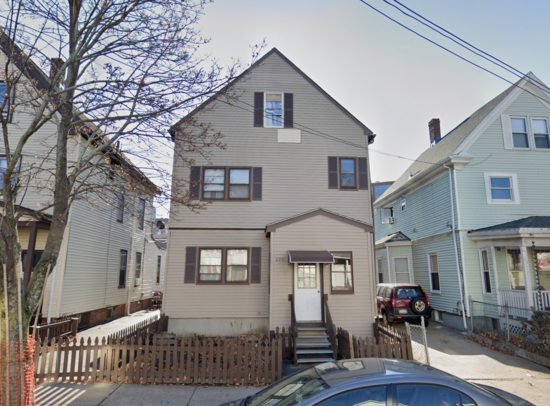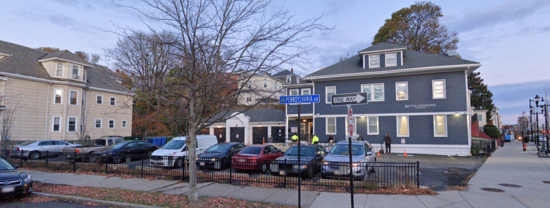With the new Affordable Housing Overlay District ( ordinance 2020-27) here in Somerville, affordable housing construction can be very profitable. For example, below I estimate someone could spend ~$220/sqft and sell for ~$550/sqft, all while helping fix the housing crisis. So: come build!
The new affordable housing rules, which went into effect in December, allow higher density construction on the condition that the housing be permanently affordable. This is solid politics: affordable housing is very popular here. Below, I’m going to try to estimate how much you could make if you invested in creating additional housing as efficiently as possible.
The first question is how much you would be able to earn from creating additional units. The ordinance defines “affordable dwelling unit” (ADU) as a “dwelling unit sold, leased, or rented at a price affordable to a specific household income specified by this Ordinance or other Federal, State, or local affordable housing program.” (2.1) For expediency I’m just going to look at the definition of “affordable to a specific household income” in Somerville zoning, and not also dig into Federal/State regulations. This means there’s potentially an option for less restrictive pricing that I’m not getting into.
Section 12.1 sets caps on rents and purchase prices defined by three tiers of affordability:
There are normally requirements for how many of each tier you are required to build, if you’re building ADUs as part of a market rate development, but 8.1.3.e says “development subject to this section is exempt from Section 12.1 Affordable Housing”. If you’re trying to maximize return, you build units entirely targeted at the highest tier.
The next step is to convert these multipliers into a maximum monthly payment. The Median Family Income for Boston-Cambridge-Quincy is $120,800 for 2021, so this gives us:
| studio | 1br | 2br | 3br | 4br | 5br | 6br | 7br | 8br | |
|---|---|---|---|---|---|---|---|---|---|
| Rental | $1422 | $1739 | $2041 | $2343 | $2645 | $2947 | $3249 | $3551 | $3853 |
| Sale | $1805 | $2190 | $2556 | $2923 | $3289 | $3656 | $4022 | $4389 | $4755 |
Since it looks like the sale numbers are a bit more favorable, let’s assume the units will be sold. The maximum sale price is 103% of the size of the mortgage you could get with the maximum monthly payment. Since the current rate is 2.78%, per FRED, we have:
| studio | 1br | 2br | 3br | 4br | 5br | 6br | 7br | 8br | |
|---|---|---|---|---|---|---|---|---|---|
| Price | $454k | $550k | $642k | $735k | $827k | $919k | $1,011k | $1,103k | $1,195k |
Note that mortgage rates are historically low right now, and higher rates give lower sale prices. For example, at 5% a 2br would have to sell for $490k, down 24% from $642k.
These are still more expensive than I’d like, but they’re much cheaper than anything on the market today, let alone anything in the excellent condition that new construction would be.
Working from the table you can see how much units of each size are allowed to sell for. Since this is the same all over the city, you make the most by building where land is cheapest, but as you’ll see below land costs are actually a very small portion of the total.
The next question is, how many units can you build and how large are they? The big incentive in the affordable housing overlay is that you can build much taller. This gain is largest for Mid-Rise 3 (MR3), where you can build seven stories instead of three, as long as your property does not abut anything zoned Neighborhood Residential (NR), and Mid-Rise 4 (MR4) where you can build seven stories instead of four regardless. Abutting is “to physically touch or share a contiguous boundary or border, such as a common lot line, or to be separated only by an alley or shared driveway,” which ends up excluding almost every MR3 lot in the city. So let’s look at MR4.
You are allowed to build either an apartment building or
a general building (with 40% residential and the rest
from a list of approved uses). Since there are no restrictions on
rents for the non-residential portion of a general
building you very likely earn more if you build something
that’s 60% commercial (health care or daycare) and 40% residential,
especially in a high-demand area. I’m going to ignore this, though,
and assume you just build ADUs.
There are small setback restrictions, but I think in most cases the limiting factor will just be lot coverage. For Mid-Rise 3-5 this is 90%. If a lot is 5k sqft (say, 50x100) then seven stories at 90% coverage gives you 32k sqft. This is a lot!
If you follow the requirements for a Net Zero Ready Building you’re allowed a minimum space per unit of 850 sqft. This is “has no on-site combustion for HVAC system operation and cooking equipment (all electric systems) [...] and is certifiable as Zero Carbon or higher from the International Living Future Institute, or PHIUS+ from the Passive House Institute US.” Otherwise you need 1,125 sqft for larger lots and 1,500 for smaller ones.
Let’s work two example lots, one small and one large, and see how this works out.
230 Pearl St is a small single-family that Zillow estimates at $1M:
It’s on a 2380 sqft (34x70) lot zoned MR4:
There’s a requirement for a 10ft rear setback, which on a 70ft lot has a larger effect than the 90% max coverage requirement. This won’t be the case for most lots in the city, but I chose a tiny one here. A 34x60 building at the front of the lot would give 2040ft per floor. Lose 64 sqft from each floor for a pair of staircases and another 20 for a small elevator and you get seven floors of 1956 sqft each. Build each floor two 2brs (978 sqft each) and the city allows you to sell them as $640k condos. Note that you do not need to provide any parking. With revenue of $9M and a purchase cost of $1M, break-even cost on design, permitting, demolition, construction is $557/sqft. Even if you sold them at Tier 1, $345k/unit, you’d still be profitable, with a break-even cost of $268/sqft.
Taking a larger example, 67 Broadway is a house that’s been converted into a marijuana dispensary, with a parking lot:
It’s on a 12,000 sqft lot zoned MR4:
No Zillow estimate, but it’s assessed at $1.2M. Let’s say $4M to be cautious. With lot coverage, stairs and a 40sqft elevator this is leaves 10,900 sqft for each floor. Seven floors with twelve 2br units on each floor (850 sqft each) and you have 84 units with 700 sqft per floor for hallways. You can sell each unit for $640k, so $54M revenue, $4M purchase, leaving a break-even cost of $661/sqft.
Housing construction here is typically $150 - $200 per sqft and demolition is ~$10/sqft (on a much smaller structure). This leaves a lot of room for me being too optimistic and you still walk away with a substantial profit.
One way to find properties that might be a good fit is to look for parcels zoned MR4-MR5 with a large lot area for their valuation. While valuations aren’t all that accurate, they’re still reasonably correlated with what a sale would be. I made a table of these parcels, sorted by valuation per squre foot of land: parcels.tsv. While there are definitely lots it identifies that wouldn’t work, it also has many that would.


From what I’ve been told, for someone new to an area to come in and build homes is often prohibitively difficult. Permitting and inspections are often largely about who you know rather than any sort objective measures. Finding reliable contractors who are willing and able to work with someone new is really hard.
That’s not to say it’s impossible. Just something to keep in mind!
I have experience in this area, but all of it is small town single-family or small multi-family...right now I’m just about wrapped up building a duplex on an infill lot. Total around 2000sqft built at $50/sqft. The difficulties described above makes the idea of trying what you talk about kind of scary.
The biggest obstacle for me is probably the cost of living adjustment moving from where we are to there is seem basically insurmountable. I own a nice 10 year old 2400sqft home. I could get maybe $210,000 out of it now and walk away with $100,000. Which doesn’t sound like it’d go far in Somerville.
If you buy one, l assume you can’t then rent it out at market rate? What restrictions are there on your ability to resell it? I would expect that to massively decrease these units’ value to potential buyers.
Massively decreasing the value (and hence the price) is the point!
You can rent or sell, at a specified maximum rate, to anyone whose income is under a limit.
Agree with Jeff on this one. This program is interesting because it is 100% affordable, so you don’t have market-rate renters/buyers cross-subsidizing affordable renters/buyers—instead the developer’s bottom line takes a hit. This hit is compensated with increased density. While this is a great start, it still requires a lottery system for applicants, which is inherently inequitable to those who are not selected but have a need, and it points to the fact that density restrictions are arbitrary! i.e. the city decides that for this case density isn’t harmful to the neighbors, which means it is likely an artificial cap. I hope that we can ween ourselves off anti-housing regulations and get towards a truly affordable market while still using regulations to avoid real nuisances like noise, odor, pollution.
I’m hopeful that we can build enough that we don’t even need a lottery, because the market price for affordable housing will fall below the maximum the city allows them to charge.
thats a good point
Care to express some kind of numerical confidence and a timeline?
Right, but that impacts whether it’s actually profitable to build them.